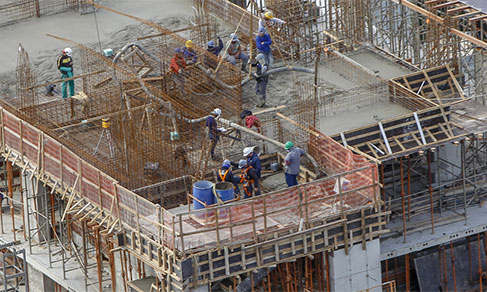2022 Census
Between 2010 and 2022, Brazilian population grows 6.5%, reaches 203.1 million
June 28, 2023 10h00 AM | Last Updated: July 03, 2023 11h32 AM
Highlights
- The Brazilian population reached 203.1 million in 2022, an increase of 6.5% over the previous Population Census, carried out in 2010. It represents an increase of 12.3 million persons in the period.
- Between 2010 and 2022, the annual growth rate of the Brazilian population was 0.52%. This is the lowest rate since the first Brazilian Census, in 1872.
- The Southeast Region has 84.8 million inhabitants, which represents 41.8% of the Brazilian population. The three most populous Brazilian states - São Paulo, Minas Gerais and Rio de Janeiro - concentrate 39.9% of the Brazilian population.
- The Central-West Region is the less populous, with 16.3 million inhabitants, or 8.0% of the Brazilian population.
- In 2022, urban concentrations housed 124.1 million people, 61%.
- Nearly 44.8% of the Brazilian municipalities had up to 10 thousand inhabitants, but only 12.8 million persons, or 6.3% of the population lieved in cities of this size.
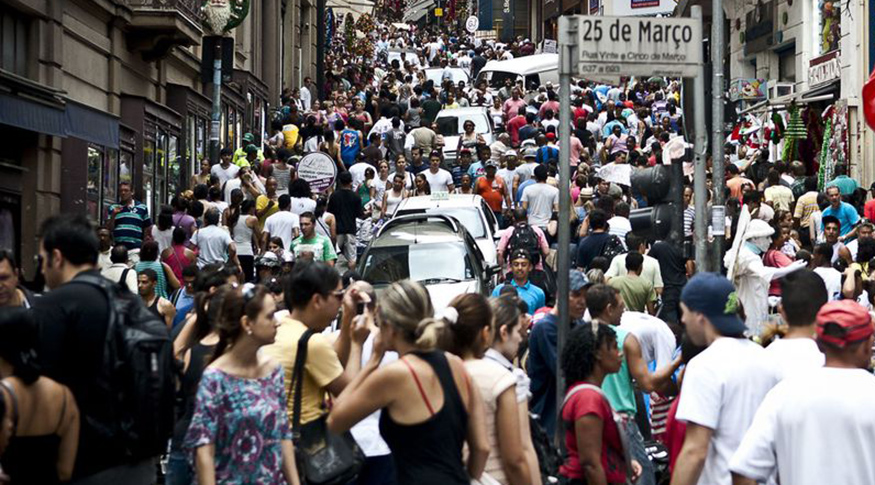
Brazil had 203,062,512 inhabitants on August 1, 2022. Since the previous Population Census in 2010, the Brazilian population grew 6.5% or more 12,306,713 persons. It results an annual growth rate of 0.52%, the lowest one ever noticed since the beginning of the time series in 1872, year of the first census operation in Brazil. These are the first results of the 2022 Population Census, released today (28) by the IBGE.
In the 150 years that separate the first census operation from the last one, Brazil increased its population more than 20 times: altogether, an increase of 193.1 million inhabitants. The biggest growth, in absolute numbers, was registered between the 1970s and 1980s, when 27.8 million persons were included. Yet, the Census time series shows that the annual growth rate has been decreasing since the 1960s. “In 2022, the annual growth rate was reduced to less than half it was in 2010 (1.17%),” states Luciano Duarte, the Census Technical Coordinator.
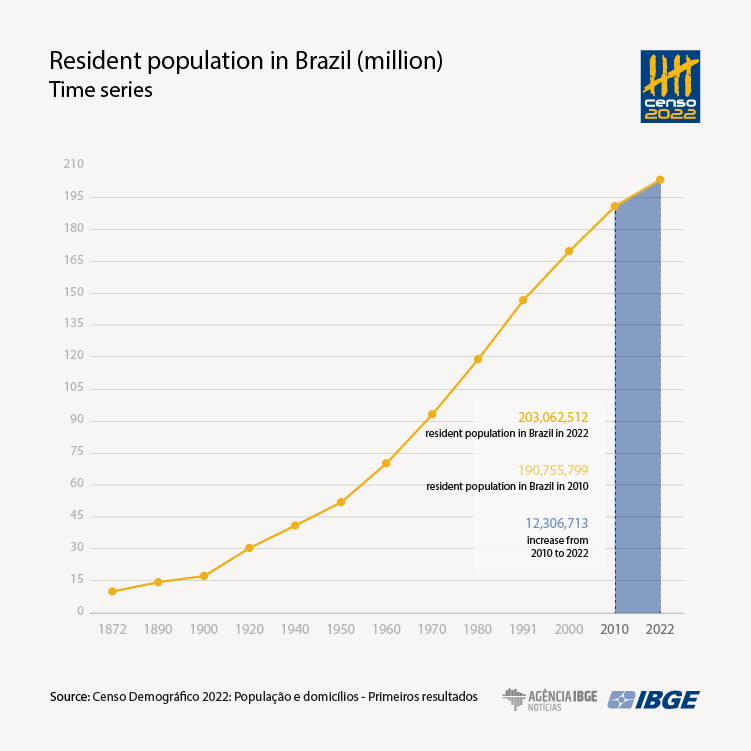
The Southeast remains the most populous region of Brazil, reaching 84.8 million inhabitants in 2022. That contingent represented 41.8% of the Brazilian population. The Northeast, where 54.6 million persons lived, accounted for 26.9% of the Brazilian inhabitants. The two regions recorded the lowest annual growth rates since the 2010 Census: while the population of the Northeast reported an annual growth rate of 0.24%, that of the Southeast was 0.45%.
On the other hand, the North was the second less populous region, with 17.3 million inhabitants, representing 8.5% of the Brazilian residents. The share of that region has been continuously growing over the last decades. The annual growth rate was 0.75%, the second highest among the regions, though quite below that registered in the previous inter-census period (2000/2010), in which this percentage was 2.09%. That means that, although the population continues to grow, the growth pace of the number of inhabitants of the North is lower than that in the previous decade.
The annual growth rate of the North, compared with 2010 data, was only lower than that of the Central-West (1.23%), a region that reached 16.3 million inhabitants, the lowest contingent among the regions. That means an increase of 15.8% in 12 years. The South, which concentrated 14.7% of the Brazilian inhabitants, increased its population contingent by 9.3% in the same period, reaching 29.9 million people.
São Paulo remains the most populous state in Brazil
The first results of the 2022 Census also pointed out that São Paulo, Minas Gerais and Rio de Janeiro remain the most populous states in Brazil. Together, the three states concentrated 39.9% of the Brazilian population. São Paulo, the biggest one in terms of population, had 44.4 million inhabitants. Nearly one fifth of the Brazilian population (21.8%) lived in that state.
Roraima also remains as the less populous state, with 636.3 thousand inhabitants, though it showed the highest annual growth rate in the 12-year period (2.92%). It was followed by Amapá (733.5 thousand) ans Acre (830 thousand).
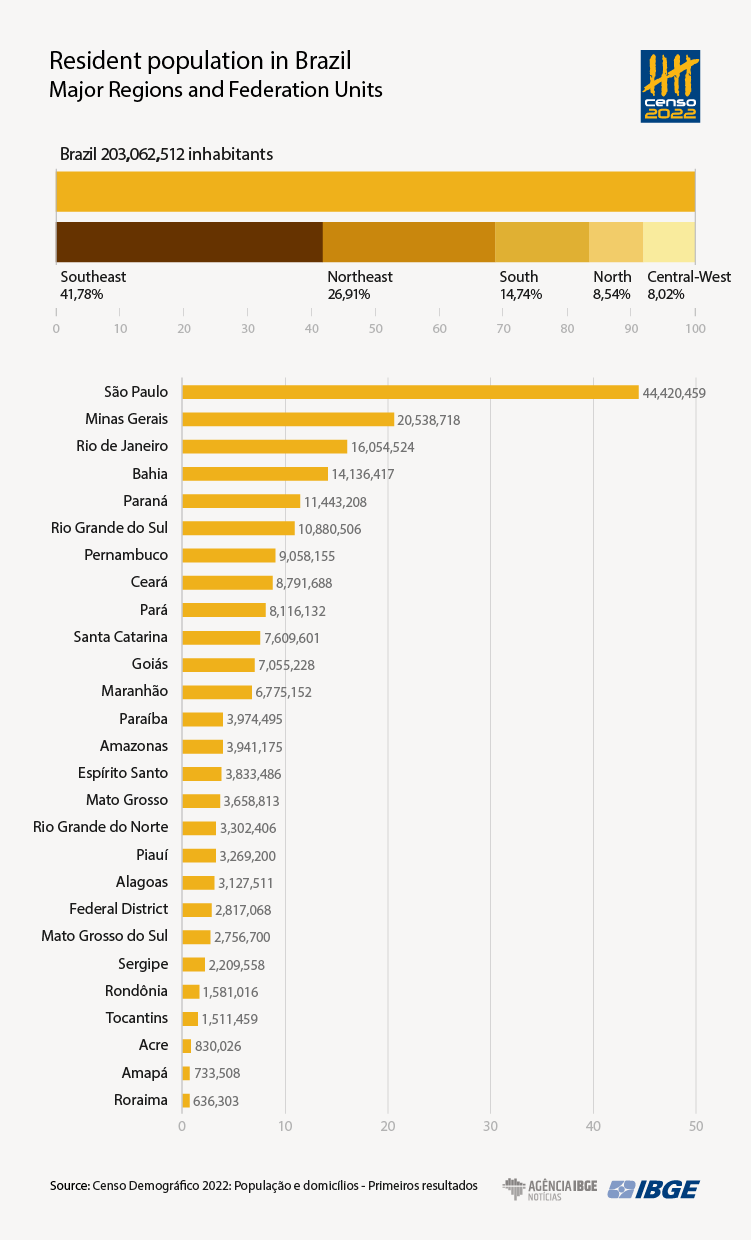
Fourteen states and the Federal District registered annual growth rates above the national average (0.52%) in 2022. In addition to Roraima, which changed from a population of 450,479 (2.92%) in 2010 to 636,303 in 2022, the population growth in Santa Catarina (1.66%), Mato Grosso (1.57%), Goiás (1.35%), Amazonas (1.03%) and Acre (1.03%) stood out as well.
Among the states that less grew (with a change of 0.1% or less) is Rio de Janeiro (0.03%), the third one most populous in Brazil. The population of Rio de Janeiro changed from 15.9 million in 2010 to 16.1 million in 2022. The others were Alagoas (0.02%), Bahia (0.07%) and Rondônia (0.10%).
Nearly half of Brazilian municipalities have up to 10 thousand inhabitants
Brazil has 5,570 municipalities and nearly half (44.8%) of this total had up to 10 thousand inhabitants in 2022. 12.7 million persons lived in those 2,495 municipalities. Most of the Brazilian population (57% of the total) lived in only 319 municipalities, which, according to the publication, highlights that persons are concentrated in urban center above 100 thousand inhabitants.
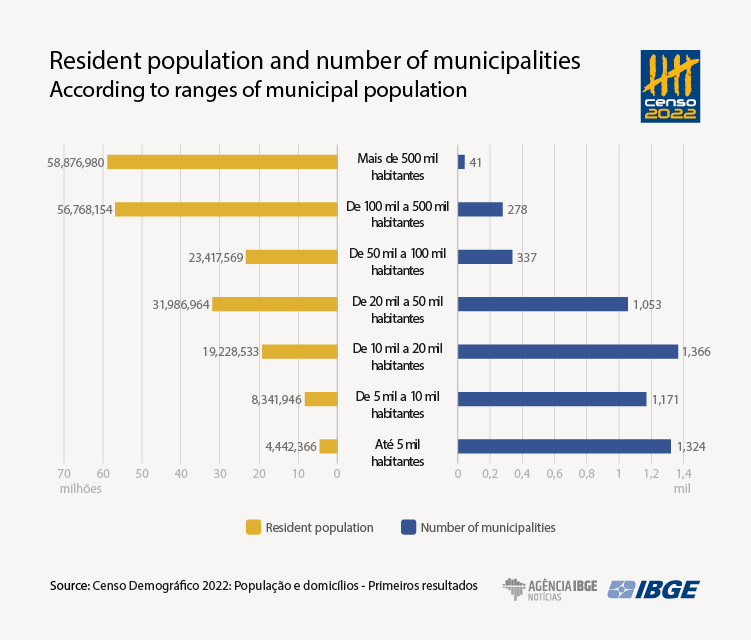
The 20 most populous Brazilian municipalities concentrated 22.1% of the total population and 17 of them are capitals. The others were Guarulhos and Campinas, in São Paulo, and São Gonçalo, in Rio de Janeiro. São Paulo is ranked in the first position, with 11.5 million inhabitants, followed by Rio de Janeiro (6.2 million) and Brasília (2.8 million).
In contrast, three municipalities had less than one thousand inhabitants: Serra da Saudade, in Minas Gerais, with 833 persons, Borá, in São Paulo (907), and Anhanguera, in Goiás (924). The 20 municipalities with less inhabitants concentrated only 0.01% of the population.
| Municipalities with the biggest populations | ||||
|---|---|---|---|---|
| FU | Municipality | Population | Change | |
| 2010 | 2022 | |||
| SP | São Paulo | 11,253,503 | 11,451,245 | 1.80% |
| RJ | Rio de Janeiro | 6,320,446 | 6,211,423 | -1.70% |
| DF | Brasília | 2,570,160 | 2,817,068 | 9.60% |
| CE | Fortaleza | 2,452,185 | 2,428,678 | -1.00% |
| BA | Salvador | 2,675,656 | 2,418,005 | -9.60% |
| MG | Belo Horizonte | 2,375,151 | 2,315,560 | -2.50% |
| AM | Manaus | 1,802,014 | 2,063,547 | 14.50% |
| PR | Curitiba | 1,751,907 | 1,773,733 | 1.20% |
| PE | Recife | 1,537,704 | 1,488,920 | -3.20% |
| GO | Goiânia | 1,302,001 | 1,437,237 | 10.40% |
| RS | Porto Alegre | 1,409,351 | 1,332,570 | -5.40% |
| PA | Belém | 1,393,399 | 1,303,389 | -6.50% |
| SP | Guarulhos | 1,221,979 | 1,291,784 | 5.70% |
| SP | Campinas | 1,080,113 | 1,138,309 | 5.40% |
| MA | São Luís | 1,014,837 | 1,037,775 | 2.30% |
| AL | Maceió | 932,748 | 957,916 | 2.70% |
| MS | Campo Grande | 786,797 | 897,938 | 14.10% |
| RJ | São Gonçalo | 999,728 | 896,744 | -10.30% |
| PI | Teresina | 814,230 | 866,300 | 6.40% |
| PB | João Pessoa | 723,515 | 833,932 | 15.30% |
| Municipalities with the smallest populations | ||||
|---|---|---|---|---|
| FU | Municipality | Population | Change | |
| 2010 | 2022 | |||
| MG | Serra da Saudade | 815 | 833 | 2.20% |
| SP | Bora | 805 | 907 | 12.70% |
| GO | Anhanguera | 1,020 | 924 | -9.40% |
| MT | Araguainha | 1,096 | 1,010 | -7.80% |
| SP | Nova Castilho | 1,125 | 1,062 | -5.60% |
| MG | Cedro do Abaete | 1,210 | 1,081 | -10.70% |
| RS | Andre da Rocha | 1,216 | 1,135 | -6.70% |
| TO | Oliveira de Fátima | 1,037 | 1,164 | 12.20% |
| RS | União da Serra | 1,487 | 1,170 | -21.30% |
| MG | São Sebastião do Rio Preto | 1,613 | 1,259 | -21.90% |
| RS | Coqueiro Baixo | 1,528 | 1,290 | -15.60% |
| RS | Engenho Velho | 1,527 | 1,296 | -15.10% |
| PI | Miguel Leão | 1,253 | 1,318 | 5.20% |
| PR | Nova Aliança do Ivai | 1,431 | 1,323 | -7.50% |
| PR | Jardim Olinda | 1,409 | 1,343 | -4.70% |
| RS | Carlos Gomes | 1,607 | 1,368 | -14.90% |
| RS | Tupanci do Sul | 1,573 | 1,374 | -12.70% |
| SP | Uru | 1,251 | 1,387 | 10.90% |
| GO | Lagoa Santa | 1,254 | 1,390 | 10.80% |
| MG | Grupiara | 1,373 | 1,392 | 1.40% |
Among the municipalities with more than 100 thousand inhabitants with the highest percent increase in the population contingent are Senador Ganedo, in Goiás, which changed from 84.4 thousand residents in 2010 to 155.6 thousand in 2022 (growth of 84.3%) and Fazenda Rio Grande, in Paraná, whose population was 81.7 thousand and reached 148.9 thousand (82.3%).
The municipalities with a population above 100 thousand people that recorded the highest percent retraction in the population were São Gonçalo, in Rio de Janeiro, which reached 896.7 thousand inhabitants (drop of 10.3%), Salvador (-9.6%) and Itabuna (-8.8%), both of them in Bahia. Salvador changed from 2.7 million inhabitants to 2.4 million in the inter-census period.
Claudio Stenner, IBGE´s Director of Geosciences, reinforces that the reduction in the number of inhabitants in the metropoles is unprecedented in Brazil. “Many times the core municipality of the metropolis, in that urban concentration, loses population, but neighbor cities gain residents. That is due to the dispersal of the urban fabric beyond the municipal borders. That means new expansions, even due to depletion of areas in that municipality. That is an important part of the explanation of that phenomenon,” says him.
In absolute numbers, the three cities above 100 thousand inhabitants that registered the highest population increase are capitals, highlighted by Manaus, in Amazonas, which changed from 1.8 million to 2.1 million, an increase of 261.5 thousand persons in 12 years. In that period, the population of Brasília, the federal capital, increased by 246.9 thousand persons, whereas the growth of São Paulo was of 197.7 thousand inhabitants.
Among the reductions, considering the absolute numbers, are Salvador, with a retraction of 257.7 thousand persons and São Gonçalo (-102.9 thousand), municipalities that stood out in the percent reduction among those with more than 100 thousand inhabitants. The capital of Rio de Janeiro (-109 thousand) was the second municipality that mostly lost population since 2010.
Nearly 124 million live in urban concentrations
In 2022, 124.1 million persons lived in urban concentrations, which are either population arrangements or isolated municipalities with more than 100 thousand inhabitants. Population arrangements comprise highly integrated municipalities, usually overlapped. The agglutination of cities forms spatial units, as is the the case of São Paulo, the core of a urban concentration that gathers 37 municipalities. Other examples of concentrations in Brazil are Belo Horizonte, in Minas Gerais (23), and Rio de Janeiro (21).
“Urban concentrations might comprise either a single municipality or a set of highly integrated and articulated municipalities that work as a single city. It is important to analyze such urban information as, for instance, the population growth many times is due to the dispersion of the urban fabric of a municipality to a neighbor municipality. To understand the population growth rate of these overlapped municipalities, it is required to look at the urban concentration and their existing relations,” explains Stenner.
Compared with the 2010 Census data, the increase in the population that lived in urban concentrations was of 9.2 million persons, which represents a significant part of the growth in Brazil. Brazil has 185 urban concentrations and most of them (80) was in the Southeast. It was followed by the Northeast and South, with 37 each. On the other side were 4,218 municipalities with less than 25 thousand inhabitants. Nearly 19.7% of the population lived there.
More about the survey
The Population Census is the biggest and most complete statistical operation carried out in Brazil. The survey aims at knocking the door of every household in the 5,570 Brazilian municipalities to produce an accurate picture of the society. In the first results, the Census brings data on population, households, municipal areas and population density for Brazil, Major Regions, States, Federal District, Municipalities and urban concentrations. Access the major results, graphs and maps on the hotsite Overview of the 2022 Census.




















